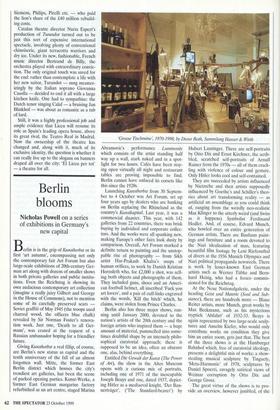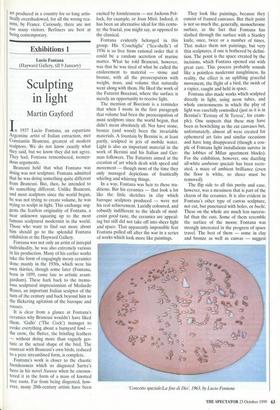Berlin blooms
Nicholas Powell on a series of exhibitions in Germany's new capital Berlin is in the grip of Kunstherbst or its first 'art autumn', encompassing not only the contemporary fair Art Forum but also large-scale exhibitions of 20th-century Ger- man art along with dozens of smaller shows in both private galleries and public institu- tions. Even the Reichstag is showing its own audacious contemporary art collection (imagine a really juicy Gilbert and George in the House of Commons), not to mention some of its carefully preserved scars Soviet graffiti of May 1945 (the troops used charred wood, the officers blue chalk) revealed by Sir Norman Foster's renova- tion work. Just one, 'Death to all Ger- mans', was erased at the request of a Russian ambassador hoping for a friendlier future.
Giving Kunstherbst a real fillip, of course, are Berlin's new status as capital and the tenth anniversary of the fall of an almost forgotten wall. Mitte, the former East Berlin district which houses the city's trendiest art galleries, haS been the scene of packed opening parties. Kunst-Werke, a 'former East German margarine factory refurbished as an art centre, staged Makina 'Grosse Tischruine', 1970-1998, by Dieter Roth, Sammluni Hauser & Wirth Abramovic's performance Luminosity which consists of the artist standing half way up a wall, stark naked and in a spot- light for two hours. Cafes have been stay- ing open virtually all night and restaurant tables are proving impossible to find. Berlin cannot have unlaced its corsets like this since the 1920s.
Launching Kunstherbst from 30 Septem- ber to 4 October was Art Forum, set up four years ago by dealers who are banking on Berlin replacing the Rhineland as the country's Kunstkapital. Last year, it was a commercial disaster. This year, with 142 galleries from 22 countries, there was brisk buying by individual and corporate collec- tors. And the works were all spanking new, making Europe's other fairs look dusty by comparison. Overall, Art Forum marked a definite return to painting and the unstop- pable rise of photography — from Sikh artist Har-Prakash Khalsa's snaps of human orifices, to work by Danish Kristian Hornsleth who, for £2,000 a shot, was sell- ing both objects and photographs of them. They included guns, shoes and an Ameri- can football helmet, all inscribed 'Fuck you art lovers', and a pair of cuff-links engraved with the words, 'Kill the bitch' which, he claims, were stolen from Prince Charles.
Berlin also has three major shows, run- ning until January 2000, devoted to the nation's artists of the 20th century and the foreign artists who inspired them — a huge amount of material, pummelled into some- times doubtful shape by an intensely philo- sophical curatorial approach; there is supposed to be an idea, often an obscure one, alas, behind everything.
Entitled Die Gewalt der Kunst (The Power of Art), the show in the Altes Museum opens with a curious mix of portraits, including one of 1971 of the inescapable Joseph Beuys and one, dated 1937, depict- ing Hitler as a mediaeval knight, 'Dec Ban- nertrager', (`The Standard-bearer') by Hubert Lanzinger. There are self-portraits by Otto Dix and Ernst Kirchner, the scrib- bled, scratched self-portraits of Arnulf Rainer from the 1970s — all of them crack- ling with violence of colour and gesture. Only Hitler looks cool and self-contained.
They are succeeded by artists influenced by Nietzsche and then artists supposedly influenced by Goethe's and Schiller's theo- ries about art transforming reality — as artificial an assemblage as you could think of, ranging from the weirdly neo-realistic Max Klinger to the utterly weird (and Swiss as it happens) Symbolist Ferdinand Hodler. And, of course, Edvard Munch, who bowled over an entire generation of German artists. There are Bauhaus paint- ings and furniture and a room devoted to the Nazi idealisation of man, featuring beautiful film footage by Leni Riefensthal of divers at the 1936 Munich Olympics and Nazi political propaganda newsreels. There is work by lesser-known East German artists such as Werner Ttibke and Bern- hard Heisig, who had a fresco commis- sioned for the Reichstag.
At the Neue Nationalgalerie, under the heading Geist and Materie (Soul and Sub- stance), there are hundreds more — Blaue Reiter artists, more Munch, great works by Max Beckmann, such as his mysterious tryptich 'Abfahre of 1932-33. Beuys is again represented by two large-scale sculp- tures and Anselm Kiefer, who would only contribute works on condition they give him an entire room, gets just that. The best of the three shows is at the Hamburger Bahnhof which, free of curatorial ideology, presents a delightful mix of works; a show- stealing musical sculpture by Tinguely, `Meta-Harmonie' of 1978, sculptures by Daniel Spoerri, savagely satirical views of Weimar corruption by Otto Dix and George Grosz.
The great virtue of the shows is to pro- vide an overview, however jumbled, of the art produced in a country for so long artis- tically overshadowed, for all the wrong rea- sons, by France. Curiously, there are not too many visitors. Berliners are best at being contemporary,



















































































 Previous page
Previous page